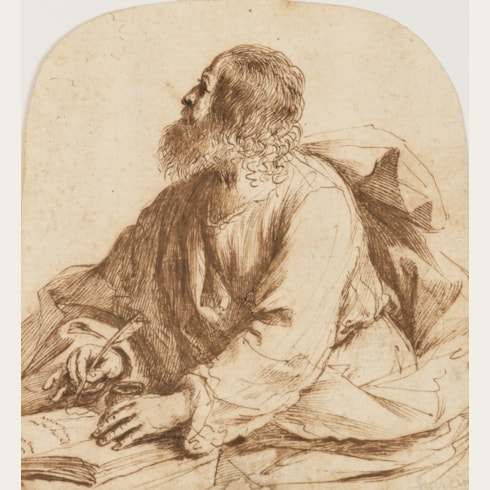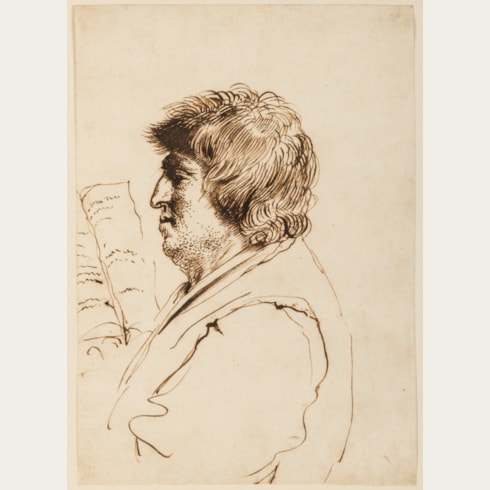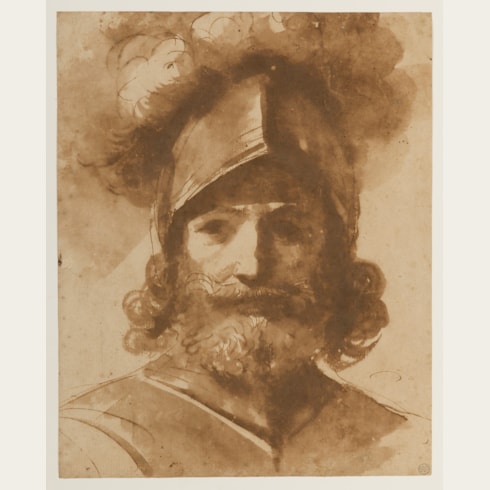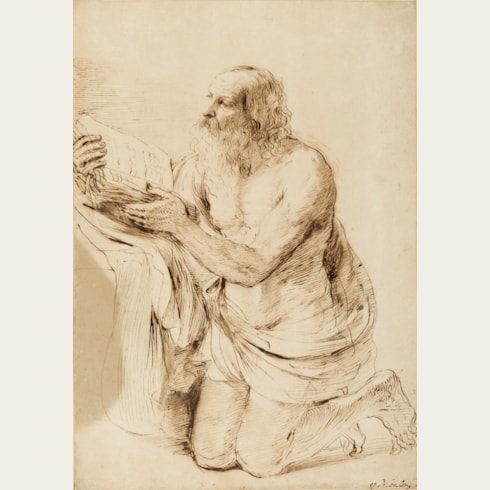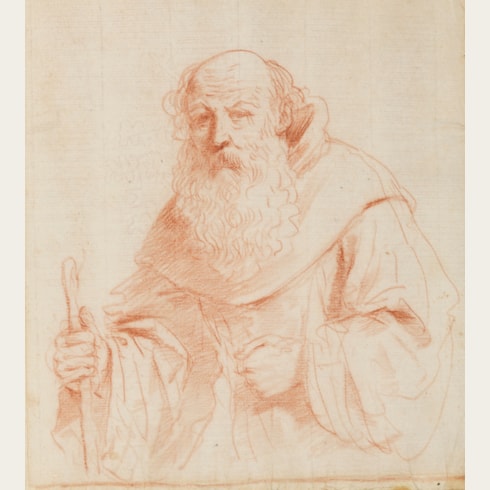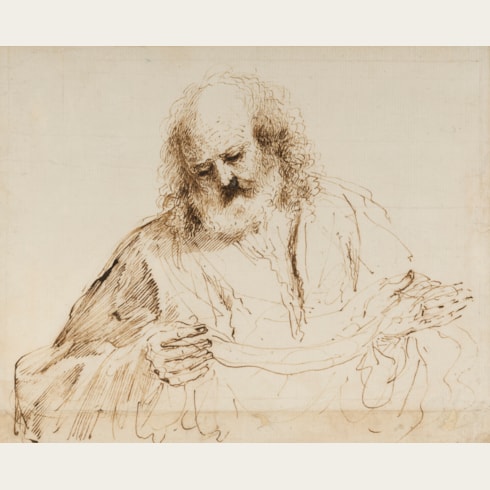Giovanni Francesco Barbieri GUERCINO
(Cento 1591 - Bologna 1666)
An Old Man Greeting Two Young Boys (Jacob Blessing the Sons of Joseph?)
A small made-up strip at the top of the sheet.
181 x 250 mm. (7 1/8 x 9 7/8 in.)
The subject here depicted is probably from the Old Testament. While it has been tentatively suggested that this drawing may represent the return of the prodigal son, the two boys appear to be too young to fit the Biblical parable. A more likely subject for our drawing, as well as those in Windsor and Chatsworth and the lost Denon sheet, would be Jacob blessing the sons of Joseph, as David Stone has recently suggested. An important episode from Hebrew scripture, the patriarchal blessing of Jacob, who was given the name Israel by God, is told in the Book of Genesis:
‘Some time later Joseph was told, “Your father is ill.” So he took his two sons Manasseh and Ephraim along with him…When Israel saw the sons of Joseph, he asked, “Who are these?” “They are the sons God has given me here,” Joseph said to his father. Then Israel said, “Bring them to me so I may bless them.” Now Israel’s eyes were failing because of old age, and he could hardly see. So Joseph brought his sons close to him, and his father kissed them and embraced them. Israel said to Joseph, “I never expected to see your face again, and now God has allowed me to see your children too.”…And Joseph took both of them, Ephraim on his right toward Israel’s left hand and Manasseh on his left toward Israel’s right hand, and brought them close to him. But Israel reached out his right hand and put it on Ephraim’s head, though he was the younger, and crossing his arms, he put his left hand on Manasseh’s head, even though Manasseh was the firstborn…When Joseph saw his father placing his right hand on Ephraim’s head he was displeased; so he took hold of his father’s hand to move it from Ephraim’s head to Manasseh’s head. Joseph said to him, “No, my father, this one is the firstborn; put your right hand on his head.” But his father refused and said, “I know, my son, I know. He too will become a people, and he too will become great. Nevertheless, his younger brother will be greater than he, and his descendants will become a group of nations.” He blessed them that day and said, “In your name will Israel pronounce this blessing: ‘May God make you like Ephraim and Manasseh.’” So he put Ephraim ahead of Manasseh.’
The present sheet would appear to depict Jacob, having blessed his younger grandson Ephraim, being confronted by the older brother Manasseh, in a manner that is also apparent in the lost Denon drawing. No related painting of this composition is known, however. Guercino had painted the subject of Jacob Blessing the Sons of Joseph early in his career, in a painting commissioned by Cardinal Jacopo Serra in 1620 and today in the National Gallery of Ireland in Dublin, but this drawing and the three other related studies would appear to be considerably later in date.
Drawings such as this are characteristic of Guercino’s approach towards using drawings to further study the relationships between figures in a painted composition. As Julian Brooks has noted, ‘Generally, Guercino would already have made studies of the relevant figure or group full length, but would draw them again up close, in half-length. Such drawings occur frequently in Guercino’s oeuvre but are unusual for other artists. Guercino often used “close-ups” to characterize the figures studied through details of facial type, hair, or dress. More importantly, however, they examine the facial expressions and gestures of the characters in relation to one another. These studies seem to be Guercino’s way of getting inside the emotional dynamics of a scene, analyzing its psychological disposition, and developing a real understanding of the narrative of the story…They are evidence of a fertile and inventive imagination looking to tell a story in the most convincing and satisfactory way possible.’
A stylistic comparison may be made with a pen and ink drawing of A Bearded Man, with his Arms held open in a Gesture of Greeting, with a Casa Gennari and Bouverie provenance, in a private British collection.
The present sheet bears the collector’s mark of the Provençal nobleman Jean-Baptiste-Florentin-Gabriel de Meryan, the Marquis de Lagoy (1764-1829), who assembled a fine collection of over three thousand drawings by nearly nine hundred artists, including several sheets by Guercino. Roughly a third of the collection was made up of Italian drawings, and many were acquired from such earlier collectors as Charles-François de Calvière, Marquis de Vézénobres, Charles-Philippe Campion, Abbé de Tersan, Jean-Dominique Magnan de La Roquette, and, in particular, the Dutchman Willem Anne Lestevenon, from whom Lagoy acquired some two thousand drawings. During his lifetime, Lagoy dispersed of small groups of drawings from his collection in private sales to dealers or fellow collectors, most significantly in 1820, when he sold 135 of his finest drawings - including several works by Raphael and Michelangelo - to the English art dealer Samuel Woodburn, who immediately sold almost all of them to the collector Thomas Dimsdale. (At Dimsdale's death, Woodburn reacquired the Lagoy drawings and sold them en bloc to Sir Thomas Lawrence.) The remainder of the Marquis de Lagoy’s collection of drawings was dispersed in two posthumous auctions held in Paris and London in April and May 1834.
Giovanni Francesco Barbieri, known as Il Guercino (‘the squinter’) because he was cross-eyed, was by the second decade of the 17th century one of the leading painters in the province of Emilia. Born in Cento, a small town between Bologna and Ferrara, Guercino was largely self-taught, although his early work was strongly influenced by the paintings of Ludovico Carracci. In 1617 he was summoned to Bologna by Alessandro Ludovisi, the Cardinal Archbishop of Bologna, and there painted a number of important altarpieces, typified by the Saint William Receiving the Monastic Habit, painted in 1620 and now in the Pinacoteca Nazionale in Bologna. When Ludovisi was elected Pope Gregory XV in 1621, Guercino was summoned to Rome to work for the pontiff and his nephew, Cardinal Ludovico Ludovisi. It was in Rome that Guercino painted some of his most celebrated works, notably the ceiling fresco of Aurora in the Casino Ludovisi and the large altarpiece of The Burial and Reception into Heaven of Saint Petronilla for an altar in Saint Peter’s. The papacy of Gregory XV was short-lived, however, and on the death of the Pope in 1623 Guercino returned to his native Cento. He remained working in Cento for twenty years, though he continued to receive commissions from patrons throughout Italy and beyond, and turned down offers of employment at the royal courts in London and Paris. Following the death of Guido Reni in 1642, Guercino moved his studio to Bologna, where he received commissions for religious pictures of the sort that Reni had specialized in, and soon inherited his position as the leading painter in the city.
Guercino was among the most prolific draughtsmen of the 17th century in Italy, and his preferred medium was pen and brown ink, although he also worked in red chalk, black chalk, and charcoal. He appears to have assiduously kept his drawings throughout his long career, and to have only parted with a few of them. Indeed, more drawings by him survive today than by any other Italian artist of the period. On his death in 1666 all of the numerous surviving sheets in his studio passed to his nephews and heirs, the painters Benedetto and Cesare Gennari, known as the ‘Casa Gennari’.
The drawings of Guercino, which include figural and compositional studies, landscapes, caricatures and genre scenes, have always been coveted by later collectors and connoisseurs. Indeed, the 18th century amateur Pierre-Jean Mariette noted of the artist that ‘Ce peintre a outre cela une plume tout-à-faite séduisante’. The largest extant group of drawings by Guercino is today in the Royal Collection at Windsor Castle; these were acquired from the Gennari family by King George III’s librarian, Richard Dalton, between about 1758 and 1764.
Provenance
Possibly his sale, London, Christie’s, 27 May 1834
Ernest Pinkus Antiques, New York
Private collection.






















